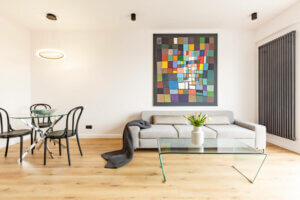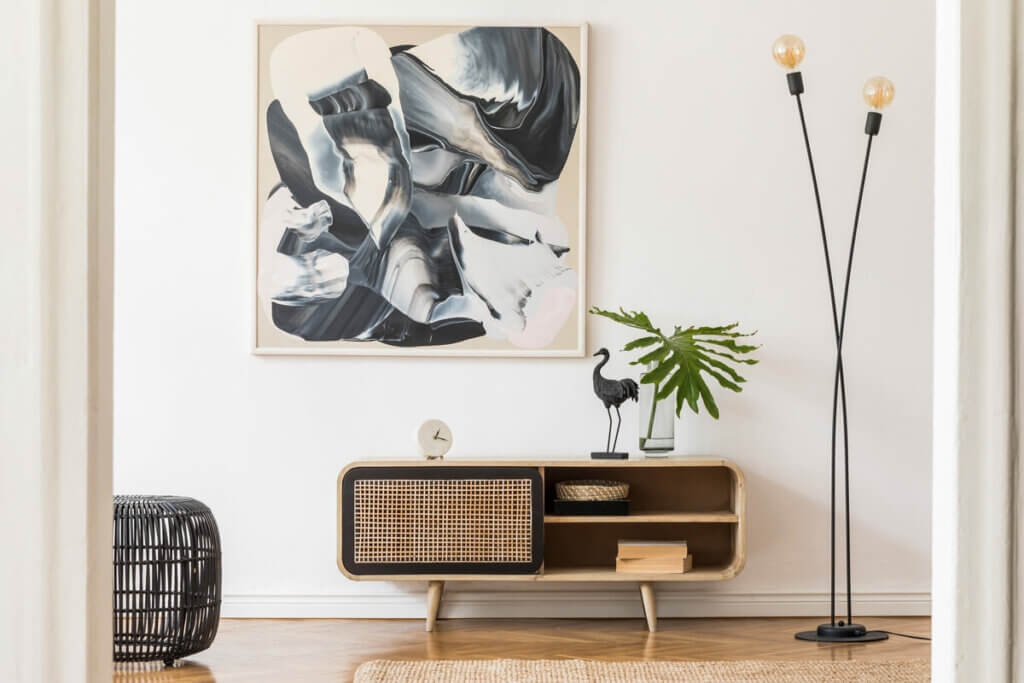Why Decorate With Paintings?

When it comes to completing interiors, you should use furnishings that create an intriguing atmosphere but that, at the same time, relate to the whole design. Works of art are a good option, and the following question arises: why decorate with paintings?
To answer this question, you must consider several factors. One of them is personal taste. Undoubtedly, your perception of interior aesthetics will depend, substantially, on the furnishings you use and whether they’re to your liking.
It’s crucial that you can show off the beauty of certain art to delight your guests. Basically, it’s a way to exemplify your refined taste. Of course, the style or artistic elements of each piece also play an important role.
Vibrancy and personality

When considering what paintings contribute to interior design, it’s important to understand that they should add vibrancy to the rooms they occupy. But in order to achieve this, it’s important to choose the right size, always taking into account where you intend to hang them.
If you want a painting to be prominent and bold, you can opt for a large canvas; however, other smaller options can look great in corridors, living rooms, the entrance hall, etc..
As well as this, it’s important to show that you have personality. In this sense, your choice of paintings and their style will be defined through their technique, theme and colors. They’re a subtle and sophisticated way to achieve an objective: aesthetic enrichment.
A great way to decorate and pull a room together.
A quality contribution to style
Style is not only defined by the decorative elements between the four walls; paintings are another way to decorate without falling back on traditional and conventional ideas.
- First of all, it’s clear that paintings provide a defined style; if you want your house to have a contemporary or avant-garde feel, you need to choose art in this style. This is the formula to achieve harmony in design.
- If you’re looking for a classic atmosphere, then you can choose paintings with traditional themes, such as portraits, landscapes, still life, etc. These are typical of the Renaissance, Baroque, Romanticism, periods.
- The goal of all this is not only to choose a painting that you like, but to add a personalized and distinctive touch. In fact, paintings have a lot to say and can become an aesthetic reference in any part of the house.
- Where you hang a painting should enhance it and add to its character and meaning. In a bedroom, the living room or in the hall, it offers direct visual communication and can lift your spirits each time you look at it.
A way of unifying spaces around a theme

Believe it or not, people tend to choose certain shapes and designs in order to communicate meaning. Paintings usually include color and lines and a scene that reflects meaning.
In this way, you unify a space around a theme. Your personality is a reflection of what appears in the painting. If you’re calm and peaceful, you’ll tend to choose landscapes, while contemporary art is more suited to eccentric and individual characters. The theme of a room depends on the style of painting you choose and, consequently, the atmosphere that’s created.
Before choosing the paintings you should take a look around you.
The relationship between paintings and decoration
Obviously, paintings should be in harmony with the decoration. There should be no unnecessary tension. The aim is to produce a visual effect through themes, shapes and colors.
Paintings must have a relationship with the rest of the furnishings. This is the only way to communicate sophistication. To make a specific aesthetic contribution within your home there’s nothing better than using paintings.
When it comes to completing interiors, you should use furnishings that create an intriguing atmosphere but that, at the same time, relate to the whole design. Works of art are a good option, and the following question arises: why decorate with paintings?
To answer this question, you must consider several factors. One of them is personal taste. Undoubtedly, your perception of interior aesthetics will depend, substantially, on the furnishings you use and whether they’re to your liking.
It’s crucial that you can show off the beauty of certain art to delight your guests. Basically, it’s a way to exemplify your refined taste. Of course, the style or artistic elements of each piece also play an important role.
Vibrancy and personality

When considering what paintings contribute to interior design, it’s important to understand that they should add vibrancy to the rooms they occupy. But in order to achieve this, it’s important to choose the right size, always taking into account where you intend to hang them.
If you want a painting to be prominent and bold, you can opt for a large canvas; however, other smaller options can look great in corridors, living rooms, the entrance hall, etc..
As well as this, it’s important to show that you have personality. In this sense, your choice of paintings and their style will be defined through their technique, theme and colors. They’re a subtle and sophisticated way to achieve an objective: aesthetic enrichment.
A great way to decorate and pull a room together.
A quality contribution to style
Style is not only defined by the decorative elements between the four walls; paintings are another way to decorate without falling back on traditional and conventional ideas.
- First of all, it’s clear that paintings provide a defined style; if you want your house to have a contemporary or avant-garde feel, you need to choose art in this style. This is the formula to achieve harmony in design.
- If you’re looking for a classic atmosphere, then you can choose paintings with traditional themes, such as portraits, landscapes, still life, etc. These are typical of the Renaissance, Baroque, Romanticism, periods.
- The goal of all this is not only to choose a painting that you like, but to add a personalized and distinctive touch. In fact, paintings have a lot to say and can become an aesthetic reference in any part of the house.
- Where you hang a painting should enhance it and add to its character and meaning. In a bedroom, the living room or in the hall, it offers direct visual communication and can lift your spirits each time you look at it.
A way of unifying spaces around a theme

Believe it or not, people tend to choose certain shapes and designs in order to communicate meaning. Paintings usually include color and lines and a scene that reflects meaning.
In this way, you unify a space around a theme. Your personality is a reflection of what appears in the painting. If you’re calm and peaceful, you’ll tend to choose landscapes, while contemporary art is more suited to eccentric and individual characters. The theme of a room depends on the style of painting you choose and, consequently, the atmosphere that’s created.
Before choosing the paintings you should take a look around you.
The relationship between paintings and decoration
Obviously, paintings should be in harmony with the decoration. There should be no unnecessary tension. The aim is to produce a visual effect through themes, shapes and colors.
Paintings must have a relationship with the rest of the furnishings. This is the only way to communicate sophistication. To make a specific aesthetic contribution within your home there’s nothing better than using paintings.
All cited sources were thoroughly reviewed by our team to ensure their quality, reliability, currency, and validity. The bibliography of this article was considered reliable and of academic or scientific accuracy.
- AA. VV.: Espais interiors. Casa i art: des del siegle XVIII al XXI, Barcelona, Universitat de Barcelona, 2007.







